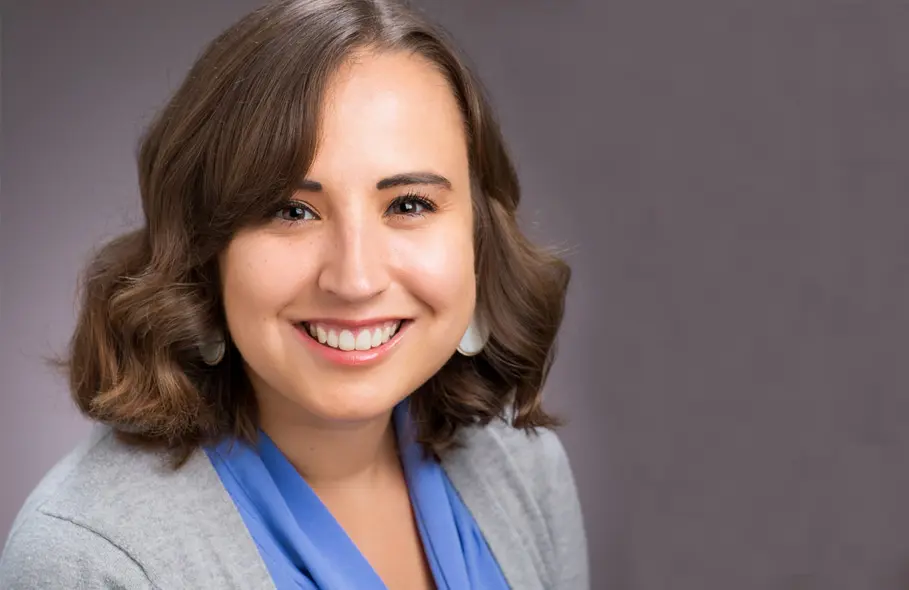A More Equitable Future: Empowering Students With Vision Impairments
by Tom Hanlon / Feb 12, 2024

Michele Schutz is playing an integral role in making the transition to adulthood more equitable and more successful for high school students who are blind or have low vision.
Kids often have a difficult time transitioning from high school to adulthood.
That transition is often made even more complex for students who are blind or have low vision.
That’s where people like Michele Schutz—and projects like EMPOWERing Youth with Visual Impairment—come in.
Schutz, an assistant professor in the Special Education Department in the College of Education, is co-principal investigator in a project funded by the U.S. Department of Education’s Office of Special Education Programs (OSEP).
“EMPOWER stands for ‘equipping more professionals on work and education in rural communities,’” Schutz says. “The intention of the project is to fulfill some of the systemic gaps that hinder transition services from meeting the needs of students with blindness or low vision.”
Falling Through the Cracks
Students with visual impairment can easily fall through the cracks as they transition out of high school, Schutz says. “It’s an exciting and complex time for everyone, but unfortunately, the school system oftentimes falls short in ensuring that students with disabilities have access to high-quality experiences, resources, and linkages that are really important in making that transition smooth and successful.”
Students in rural and remote communities may face additional barriers to accessing transition supports, she says, because the gaps in available services are often even more pervasive. “Students might find themselves as the only student in their school or community who has low vision or is blind,” she points out.
Team Effort
Schutz is part of a six-person team that received a five-year, $2.5M grant from OSEP to create virtual supports related to the transition period for high school students with blindness or low vision. Her colleagues are from Vanderbilt University and Baylor University.
“Across our team, we bring expertise and experience related to visual impairment, school-based transition services, disability services, and rural school communities,” she says. “My research background centers upon supporting rural schools in providing high-quality transition services for students with disabilities, so I’m employing that work, along with my former experiences as a high school special education teacher, to help inform the development of our website content. And our team is also leveraging our different linkages and networks within education and beyond.”
Program Goals
“Our overarching goal is to develop virtual supports that provide instructional content and resources for students who are blind or have low vision, particularly those who live in rural communities,” Schutz says. “We also want to provide accessible instruction, resources, and supports to their families and to the professionals who serve them in their schools, because we know these adults often don’t have access to these kinds of resources either.”
EMPOWER has four primary objectives:
- Develop a fully accessible website
- Produce and disseminate a monthly newsletter
- Create virtual communities of practice for families and professionals
- Establish a mentorship model
“Foremost, we’re informing these supports by the lived experiences of people with disabilities,” Schutz adds. “So, we are developing an advisory board of youth who are blind or have low vision to help us develop these supports as well as learning from the experiences of blind adults who have recently graduated.”
The website is already active and is fully accessible to screen readers and other assistive technology, Schutz says. “We’re using the website as a central location to house resources that we already know exist, that support this population in transition, and are of high quality,” she says, though she adds there aren’t many such resources available, and some are not accessible. To fill that gap, the EMPOWER team is developing a significant amount of original content, including courses for youth, families, and school and agency professionals.
EMPOWER has also already begun writing and distributing its monthly newsletter, which offers specific evidence-based practices for students, families, and school professionals to readily utilize.
The final two objectives are in the process of development, Schutz says.
“We’re creating virtual communities of practice, which are opportunities for families and for professionals to gather virtually to engage with content in short, digestible bits,” she explains. “They’ll also have the opportunity to bring forth their own challenges and bounce ideas off of one another for support.”
The team will also develop a mentorship model. “This will connect transitioning students in rural communities who are blind or have low vision with adults with similar disabilities,” Schutz says. The work- and college-related experiences of mentoring adults can support mentored students as they also transition toward successful outcomes.
Providing Equitable Access
“The post-high school outcomes of people with disabilities have long remained disparate from people without disabilities,” Schutz notes. “We know that young people with visual impairment and other types of disabilities undoubtedly possess skills, talents, and insights that contribute to their local communities, to workplaces, and to college settings. The limitations are not in the people—they’re in the extent to which we as a society provide equitable access and opportunity to disabled people.”
Schutz says the interdisciplinary collaboration of the EMPOWER project is especially significant.
“Unfortunately, in education in particular, our systems and our structures are often siloed,” she says. “We don’t always do a great job in talking to one another across tangential areas. Thus, we feel this project is really important because we’re collectively leveraging the capacities of multiple service systems and areas of expertise related to special education, rural education, rehabilitation, higher education, and the study of blindness and visual impairment, and using these joint efforts to elevate the voices of people who are blind or have low vision to tell us what their needs are, tell us where we’re falling short and what we can do to create opportunities and improve outcomes.”